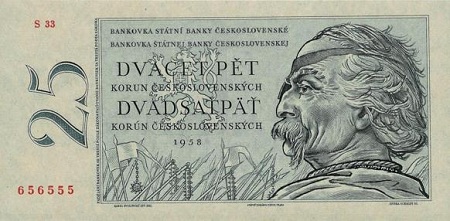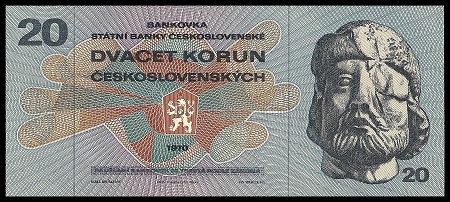CZECHOSLOVAKIA
Jan Zizka – aka – John One-Eye!

Jan (John) Zizka was born in Bohemia, and was the son of minor nobles. As a child, he was blinded in one eye during an childhood fight. According to legal records from 1378, the name Zizka seems to be a nickname meaning one-eye. During younger years, he was the Chamberlain (manager of the household) to Queen Sophia.
John Zizka was a supporter of John Hus, a religious reformer some time before Martin Luther and, like Luther did in later years, Hus opposed the sale of Indulgences to pay for sins, taught that people should appeal directly to Christ for forgiveness and was a vocal opponent of the church’s abuses. Hus was betrayed when he traveled to the Council of Constance for ecclesiastical reform and was arrested and burned alive at the stake for heresy. Many Bohemian peoples were followers of the teachings of John Hus and word of his execution led to a long revolt against the Roman Catholic Church. Zizka’s support for Hus lost him the ear of the king.
John Zizka emerged as a leader of the Taborites in 1409. The Taborites were a rather riotous Hussite (Followers of John Hus) group. In 1410, Zizka fought for the Poles as a mercenary at Grunwald (Tannenberg) defending against Teutonic knights. He returned during a religious upheaval following the death of John Hus.
John Zizka led the storming of Prague’s town hall in 1419 and, after the death of King Wenceslas IV, took a key role in the organizing of armed resistance against forces loyal to the Emperor Sigismund, Holy Roman Emperor of Bohemia and Hungary. From 1420 through 1434 the Hussite wars ensued against the followers of John Hus. These wars were the first European wars to use muskets and other handheld gunpowder weapons. Zizka assembled an army consisting mainly of peasants. Instead of teaching them how to use military equipment, Zizka had them convert their farming tools into weapons. One of the most famous was the Wagenburg, used to combat heavily armored knights. The Wagenburgs were armored farm wagons which were placed on their sides and formed into a square. 21 men – gunners, bowmen, cavalry and infantry – were in each wagonburg. After defending with howitzers, they would wait for the knights to come into range on their horses and the bowmen and gunners would take out the knight’s horses, and then they would be able to easily take out the slow moving, heavy knights. The English terms for Howitzer and Pistol are derived from the Czech language for these weapons. The Wagonberg anticipated modern armored tank warfare.
In 1420 Zizka defended the hill Vitkov near Prague and fended off the German forces led by King Sigismund. After many subsequent battles with the Germans, Zizka managed to roust out Sigismund and was elected as a representative of the Tabor region.
Zizka lost the sight in his other eye during the siege of Raby in 1421. Zizka continued to lead his forces through the battle with the aide of trusted companions, Prokop the lesser and Prokop the great. After the battle, they assisted him in his other duties. Sigismund later captured the town of Kutna Hora and trapped Zizka and an army outside the city walls. Zizka however, performed the first ever mobile artillery movement and broke through the enemy lines, gathered up reinforcements and attacked Sigismund, killing 12,000 men.
In 1423, finding some disagreements with the Taborites, Zizka broke away and created the Orebites, a more moderate wing of the Hussites. Before he could lead an army a last time into Moravia, He died from the plague in Prysbislav in 1424. Zizka was so well liked that after his death, the Orebites changed their name to the Orphans because they felt like they had lost their father. John Zizka wrote the first code of military conduct after his troops disobeyed his orders and killed inhabitants of a town. It is said that John Zizka never lost a battle.
He has been commemorated on at least two banknotes, the 25 Korun issued in 1958 and again in 1961/1962 and the 20 Korun issued in 1970. Curiously, the 25 Korun note depicts Jan Ziska’s right eye as being the one he had injured, while the 20 Korun note depicts it as his left eye.



